Khatvanga Stock Photos and Images
 A Tibetan khatvanga with silver and gold inlays, early 15th century, Cut iron. Octagonal haft entirely covered with spiral-shaped gold and silver inlays, the lower part decorated with chiselled lotus flower in relief with a half vajra and gilt makara heads. The upper section with double vajra, followed by a kalasa, two different heads with gold and silver inlays and a skull, topped by a further vajra. Length 43.3 cm. The object at hand dates back to a significant period in the history of Tibet. During the late 14th and early 15th century the risi, Additional-Rights-Clearance-Info-Not-Available Stock Photohttps://www.alamy.com/image-license-details/?v=1https://www.alamy.com/a-tibetan-khatvanga-with-silver-and-gold-inlays-early-15th-century-cut-iron-octagonal-haft-entirely-covered-with-spiral-shaped-gold-and-silver-inlays-the-lower-part-decorated-with-chiselled-lotus-flower-in-relief-with-a-half-vajra-and-gilt-makara-heads-the-upper-section-with-double-vajra-followed-by-a-kalasa-two-different-heads-with-gold-and-silver-inlays-and-a-skull-topped-by-a-further-vajra-length-433-cm-the-object-at-hand-dates-back-to-a-significant-period-in-the-history-of-tibet-during-the-late-14th-and-early-15th-century-the-risi-additional-rights-clearance-info-not-available-image247854829.html
A Tibetan khatvanga with silver and gold inlays, early 15th century, Cut iron. Octagonal haft entirely covered with spiral-shaped gold and silver inlays, the lower part decorated with chiselled lotus flower in relief with a half vajra and gilt makara heads. The upper section with double vajra, followed by a kalasa, two different heads with gold and silver inlays and a skull, topped by a further vajra. Length 43.3 cm. The object at hand dates back to a significant period in the history of Tibet. During the late 14th and early 15th century the risi, Additional-Rights-Clearance-Info-Not-Available Stock Photohttps://www.alamy.com/image-license-details/?v=1https://www.alamy.com/a-tibetan-khatvanga-with-silver-and-gold-inlays-early-15th-century-cut-iron-octagonal-haft-entirely-covered-with-spiral-shaped-gold-and-silver-inlays-the-lower-part-decorated-with-chiselled-lotus-flower-in-relief-with-a-half-vajra-and-gilt-makara-heads-the-upper-section-with-double-vajra-followed-by-a-kalasa-two-different-heads-with-gold-and-silver-inlays-and-a-skull-topped-by-a-further-vajra-length-433-cm-the-object-at-hand-dates-back-to-a-significant-period-in-the-history-of-tibet-during-the-late-14th-and-early-15th-century-the-risi-additional-rights-clearance-info-not-available-image247854829.htmlRMTB6NA5–A Tibetan khatvanga with silver and gold inlays, early 15th century, Cut iron. Octagonal haft entirely covered with spiral-shaped gold and silver inlays, the lower part decorated with chiselled lotus flower in relief with a half vajra and gilt makara heads. The upper section with double vajra, followed by a kalasa, two different heads with gold and silver inlays and a skull, topped by a further vajra. Length 43.3 cm. The object at hand dates back to a significant period in the history of Tibet. During the late 14th and early 15th century the risi, Additional-Rights-Clearance-Info-Not-Available
 Finial for a Buddhist staff (khatvanga), early 15th century Stock Photohttps://www.alamy.com/image-license-details/?v=1https://www.alamy.com/stock-image-finial-for-a-buddhist-staff-khatvanga-early-15th-century-162443912.html
Finial for a Buddhist staff (khatvanga), early 15th century Stock Photohttps://www.alamy.com/image-license-details/?v=1https://www.alamy.com/stock-image-finial-for-a-buddhist-staff-khatvanga-early-15th-century-162443912.htmlRMKC7XT8–Finial for a Buddhist staff (khatvanga), early 15th century
 Art inspired by Ritual Staff (Khatvanga), Ming dynasty (1368–1644), Yongle period (1403–24), 1403–1424, China, Iron inlaid with gold and silver, L. 11 1/8 in. (28.3 cm), Metalwork, Linear scrolls decorate the handle of this ritual staff (khatvanga), which is thought to quell demons and, Classic works modernized by Artotop with a splash of modernity. Shapes, color and value, eye-catching visual impact on art. Emotions through freedom of artworks in a contemporary way. A timeless message pursuing a wildly creative new direction. Artists turning to the digital medium and creating the Artotop NFT Stock Photohttps://www.alamy.com/image-license-details/?v=1https://www.alamy.com/art-inspired-by-ritual-staff-khatvanga-ming-dynasty-13681644-yongle-period-140324-14031424-china-iron-inlaid-with-gold-and-silver-l-11-18-in-283-cm-metalwork-linear-scrolls-decorate-the-handle-of-this-ritual-staff-khatvanga-which-is-thought-to-quell-demons-and-classic-works-modernized-by-artotop-with-a-splash-of-modernity-shapes-color-and-value-eye-catching-visual-impact-on-art-emotions-through-freedom-of-artworks-in-a-contemporary-way-a-timeless-message-pursuing-a-wildly-creative-new-direction-artists-turning-to-the-digital-medium-and-creating-the-artotop-nft-image462757940.html
Art inspired by Ritual Staff (Khatvanga), Ming dynasty (1368–1644), Yongle period (1403–24), 1403–1424, China, Iron inlaid with gold and silver, L. 11 1/8 in. (28.3 cm), Metalwork, Linear scrolls decorate the handle of this ritual staff (khatvanga), which is thought to quell demons and, Classic works modernized by Artotop with a splash of modernity. Shapes, color and value, eye-catching visual impact on art. Emotions through freedom of artworks in a contemporary way. A timeless message pursuing a wildly creative new direction. Artists turning to the digital medium and creating the Artotop NFT Stock Photohttps://www.alamy.com/image-license-details/?v=1https://www.alamy.com/art-inspired-by-ritual-staff-khatvanga-ming-dynasty-13681644-yongle-period-140324-14031424-china-iron-inlaid-with-gold-and-silver-l-11-18-in-283-cm-metalwork-linear-scrolls-decorate-the-handle-of-this-ritual-staff-khatvanga-which-is-thought-to-quell-demons-and-classic-works-modernized-by-artotop-with-a-splash-of-modernity-shapes-color-and-value-eye-catching-visual-impact-on-art-emotions-through-freedom-of-artworks-in-a-contemporary-way-a-timeless-message-pursuing-a-wildly-creative-new-direction-artists-turning-to-the-digital-medium-and-creating-the-artotop-nft-image462757940.htmlRF2HTTCD8–Art inspired by Ritual Staff (Khatvanga), Ming dynasty (1368–1644), Yongle period (1403–24), 1403–1424, China, Iron inlaid with gold and silver, L. 11 1/8 in. (28.3 cm), Metalwork, Linear scrolls decorate the handle of this ritual staff (khatvanga), which is thought to quell demons and, Classic works modernized by Artotop with a splash of modernity. Shapes, color and value, eye-catching visual impact on art. Emotions through freedom of artworks in a contemporary way. A timeless message pursuing a wildly creative new direction. Artists turning to the digital medium and creating the Artotop NFT
 Ritual Staff (Khatvanga). Culture: China. Dimensions: L. 11 1/8 in. (28.3 cm). Date: 1403-1424. Linear scrolls decorate the handle of this ritual staff (khatvanga), which is thought to quell demons and, by extension, the various obstacles found on one's spiritual journey. The finial of the staff consists of an overflowing vase, a long-standing Indic symbol of abundance, set beneath three heads-one human, one decaying, and one skeletal-which symbolize the inevitability of change and death. Museum: Metropolitan Museum of Art, New York, USA. Stock Photohttps://www.alamy.com/image-license-details/?v=1https://www.alamy.com/ritual-staff-khatvanga-culture-china-dimensions-l-11-18-in-283-cm-date-1403-1424-linear-scrolls-decorate-the-handle-of-this-ritual-staff-khatvanga-which-is-thought-to-quell-demons-and-by-extension-the-various-obstacles-found-on-ones-spiritual-journey-the-finial-of-the-staff-consists-of-an-overflowing-vase-a-long-standing-indic-symbol-of-abundance-set-beneath-three-heads-one-human-one-decaying-and-one-skeletal-which-symbolize-the-inevitability-of-change-and-death-museum-metropolitan-museum-of-art-new-york-usa-image213319370.html
Ritual Staff (Khatvanga). Culture: China. Dimensions: L. 11 1/8 in. (28.3 cm). Date: 1403-1424. Linear scrolls decorate the handle of this ritual staff (khatvanga), which is thought to quell demons and, by extension, the various obstacles found on one's spiritual journey. The finial of the staff consists of an overflowing vase, a long-standing Indic symbol of abundance, set beneath three heads-one human, one decaying, and one skeletal-which symbolize the inevitability of change and death. Museum: Metropolitan Museum of Art, New York, USA. Stock Photohttps://www.alamy.com/image-license-details/?v=1https://www.alamy.com/ritual-staff-khatvanga-culture-china-dimensions-l-11-18-in-283-cm-date-1403-1424-linear-scrolls-decorate-the-handle-of-this-ritual-staff-khatvanga-which-is-thought-to-quell-demons-and-by-extension-the-various-obstacles-found-on-ones-spiritual-journey-the-finial-of-the-staff-consists-of-an-overflowing-vase-a-long-standing-indic-symbol-of-abundance-set-beneath-three-heads-one-human-one-decaying-and-one-skeletal-which-symbolize-the-inevitability-of-change-and-death-museum-metropolitan-museum-of-art-new-york-usa-image213319370.htmlRMPB1F0X–Ritual Staff (Khatvanga). Culture: China. Dimensions: L. 11 1/8 in. (28.3 cm). Date: 1403-1424. Linear scrolls decorate the handle of this ritual staff (khatvanga), which is thought to quell demons and, by extension, the various obstacles found on one's spiritual journey. The finial of the staff consists of an overflowing vase, a long-standing Indic symbol of abundance, set beneath three heads-one human, one decaying, and one skeletal-which symbolize the inevitability of change and death. Museum: Metropolitan Museum of Art, New York, USA.
 Dancing female ascetic, probably a Yoginī. In her left hand is a skull club weapon made from a human femoral bone (Khatvanga) Stock Photohttps://www.alamy.com/image-license-details/?v=1https://www.alamy.com/dancing-female-ascetic-probably-a-yogin-in-her-left-hand-is-a-skull-club-weapon-made-from-a-human-femoral-bone-khatvanga-image338259974.html
Dancing female ascetic, probably a Yoginī. In her left hand is a skull club weapon made from a human femoral bone (Khatvanga) Stock Photohttps://www.alamy.com/image-license-details/?v=1https://www.alamy.com/dancing-female-ascetic-probably-a-yogin-in-her-left-hand-is-a-skull-club-weapon-made-from-a-human-femoral-bone-khatvanga-image338259974.htmlRM2AJ921A–Dancing female ascetic, probably a Yoginī. In her left hand is a skull club weapon made from a human femoral bone (Khatvanga)
 Ritual staff China Linear scrolls decorate the handle of this ritual staff (khatvanga), which is thought to quell demons and, by extension, the various obstacles found on one's spiritual journey. The finial of the staff consists of an overflowing vase, a long-standing Indic symbol of abundance, set beneath three heads-one human, one decaying, and one skeletal-which symbolize the inevitability of change and death.. Ritual staff 39392 Stock Photohttps://www.alamy.com/image-license-details/?v=1https://www.alamy.com/ritual-staff-china-linear-scrolls-decorate-the-handle-of-this-ritual-staff-khatvanga-which-is-thought-to-quell-demons-and-by-extension-the-various-obstacles-found-on-ones-spiritual-journey-the-finial-of-the-staff-consists-of-an-overflowing-vase-a-long-standing-indic-symbol-of-abundance-set-beneath-three-heads-one-human-one-decaying-and-one-skeletal-which-symbolize-the-inevitability-of-change-and-death-ritual-staff-39392-image458466337.html
Ritual staff China Linear scrolls decorate the handle of this ritual staff (khatvanga), which is thought to quell demons and, by extension, the various obstacles found on one's spiritual journey. The finial of the staff consists of an overflowing vase, a long-standing Indic symbol of abundance, set beneath three heads-one human, one decaying, and one skeletal-which symbolize the inevitability of change and death.. Ritual staff 39392 Stock Photohttps://www.alamy.com/image-license-details/?v=1https://www.alamy.com/ritual-staff-china-linear-scrolls-decorate-the-handle-of-this-ritual-staff-khatvanga-which-is-thought-to-quell-demons-and-by-extension-the-various-obstacles-found-on-ones-spiritual-journey-the-finial-of-the-staff-consists-of-an-overflowing-vase-a-long-standing-indic-symbol-of-abundance-set-beneath-three-heads-one-human-one-decaying-and-one-skeletal-which-symbolize-the-inevitability-of-change-and-death-ritual-staff-39392-image458466337.htmlRM2HHTXDN–Ritual staff China Linear scrolls decorate the handle of this ritual staff (khatvanga), which is thought to quell demons and, by extension, the various obstacles found on one's spiritual journey. The finial of the staff consists of an overflowing vase, a long-standing Indic symbol of abundance, set beneath three heads-one human, one decaying, and one skeletal-which symbolize the inevitability of change and death.. Ritual staff 39392
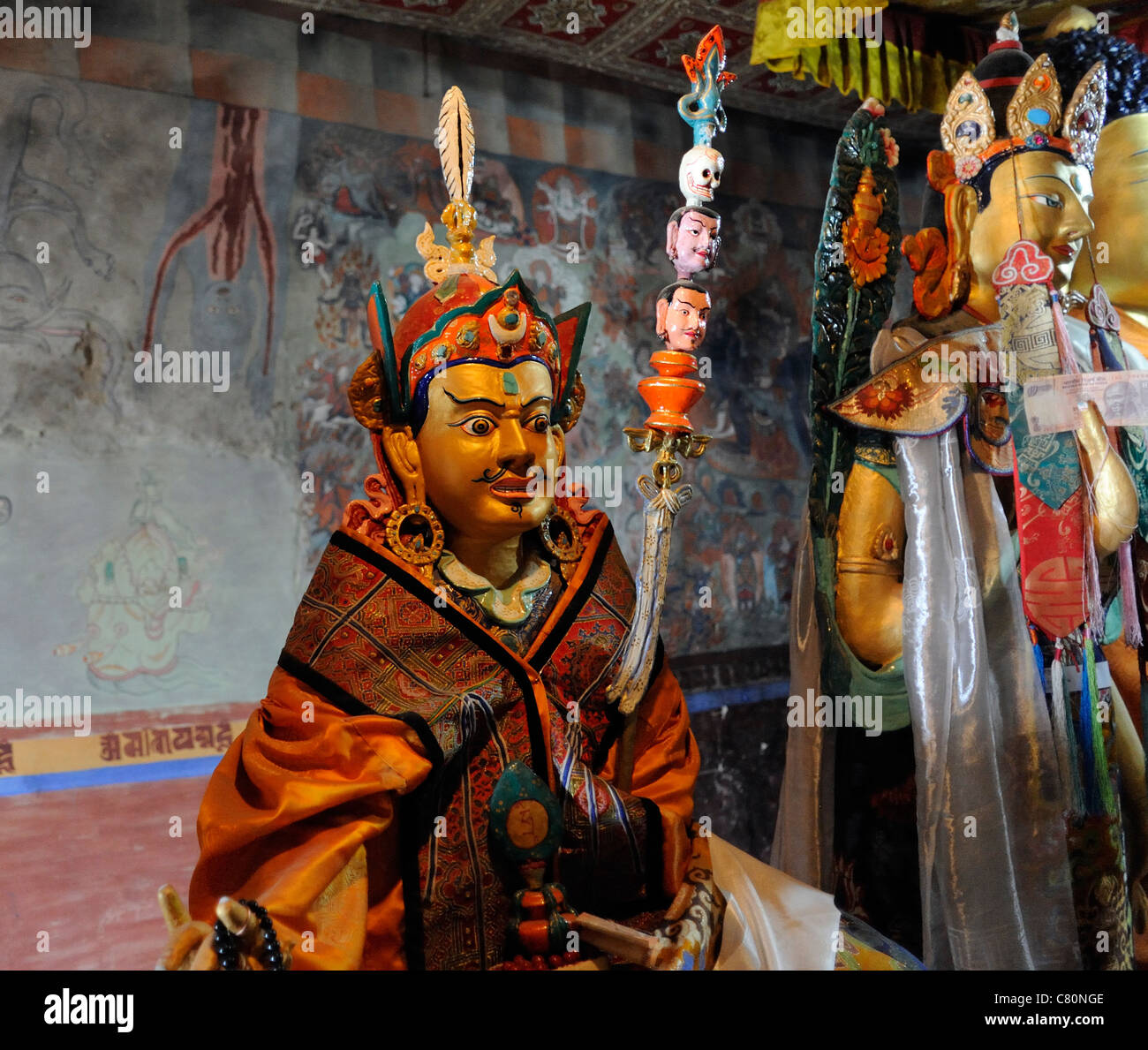 Statue of Guru Rinpoche, Precious Guru, Lopon Rinpoche, Padum, Padmasambhava, Padmakara, The Lotus Born, Tikse, Ladahk Stock Photohttps://www.alamy.com/image-license-details/?v=1https://www.alamy.com/stock-photo-statue-of-guru-rinpoche-precious-guru-lopon-rinpoche-padum-padmasambhava-39354910.html
Statue of Guru Rinpoche, Precious Guru, Lopon Rinpoche, Padum, Padmasambhava, Padmakara, The Lotus Born, Tikse, Ladahk Stock Photohttps://www.alamy.com/image-license-details/?v=1https://www.alamy.com/stock-photo-statue-of-guru-rinpoche-precious-guru-lopon-rinpoche-padum-padmasambhava-39354910.htmlRFC80NGE–Statue of Guru Rinpoche, Precious Guru, Lopon Rinpoche, Padum, Padmasambhava, Padmakara, The Lotus Born, Tikse, Ladahk
 White Jambhala on a Dragon Mongolia 18th–19th century Although part of the jewel-born family associated with the Buddha Ratnasambhava, white Jambhala is said to have been born from the right eye of the compassionate bodhisattva Avalokiteshvara. He is identifiable by the dragon he rides and his gold sword, a variant of the khatvanga ritual staff, which he holds in his left hand. He alleviates suffering from poverty and sickness and purifies nonvirtuous karmic actions. Stock Photohttps://www.alamy.com/image-license-details/?v=1https://www.alamy.com/white-jambhala-on-a-dragon-mongolia-18th19th-century-although-part-of-the-jewel-born-family-associated-with-the-buddha-ratnasambhava-white-jambhala-is-said-to-have-been-born-from-the-right-eye-of-the-compassionate-bodhisattva-avalokiteshvara-he-is-identifiable-by-the-dragon-he-rides-and-his-gold-sword-a-variant-of-the-khatvanga-ritual-staff-which-he-holds-in-his-left-hand-he-alleviates-suffering-from-poverty-and-sickness-and-purifies-nonvirtuous-karmic-actions-image569498219.html
White Jambhala on a Dragon Mongolia 18th–19th century Although part of the jewel-born family associated with the Buddha Ratnasambhava, white Jambhala is said to have been born from the right eye of the compassionate bodhisattva Avalokiteshvara. He is identifiable by the dragon he rides and his gold sword, a variant of the khatvanga ritual staff, which he holds in his left hand. He alleviates suffering from poverty and sickness and purifies nonvirtuous karmic actions. Stock Photohttps://www.alamy.com/image-license-details/?v=1https://www.alamy.com/white-jambhala-on-a-dragon-mongolia-18th19th-century-although-part-of-the-jewel-born-family-associated-with-the-buddha-ratnasambhava-white-jambhala-is-said-to-have-been-born-from-the-right-eye-of-the-compassionate-bodhisattva-avalokiteshvara-he-is-identifiable-by-the-dragon-he-rides-and-his-gold-sword-a-variant-of-the-khatvanga-ritual-staff-which-he-holds-in-his-left-hand-he-alleviates-suffering-from-poverty-and-sickness-and-purifies-nonvirtuous-karmic-actions-image569498219.htmlRM2T2ETP3–White Jambhala on a Dragon Mongolia 18th–19th century Although part of the jewel-born family associated with the Buddha Ratnasambhava, white Jambhala is said to have been born from the right eye of the compassionate bodhisattva Avalokiteshvara. He is identifiable by the dragon he rides and his gold sword, a variant of the khatvanga ritual staff, which he holds in his left hand. He alleviates suffering from poverty and sickness and purifies nonvirtuous karmic actions.
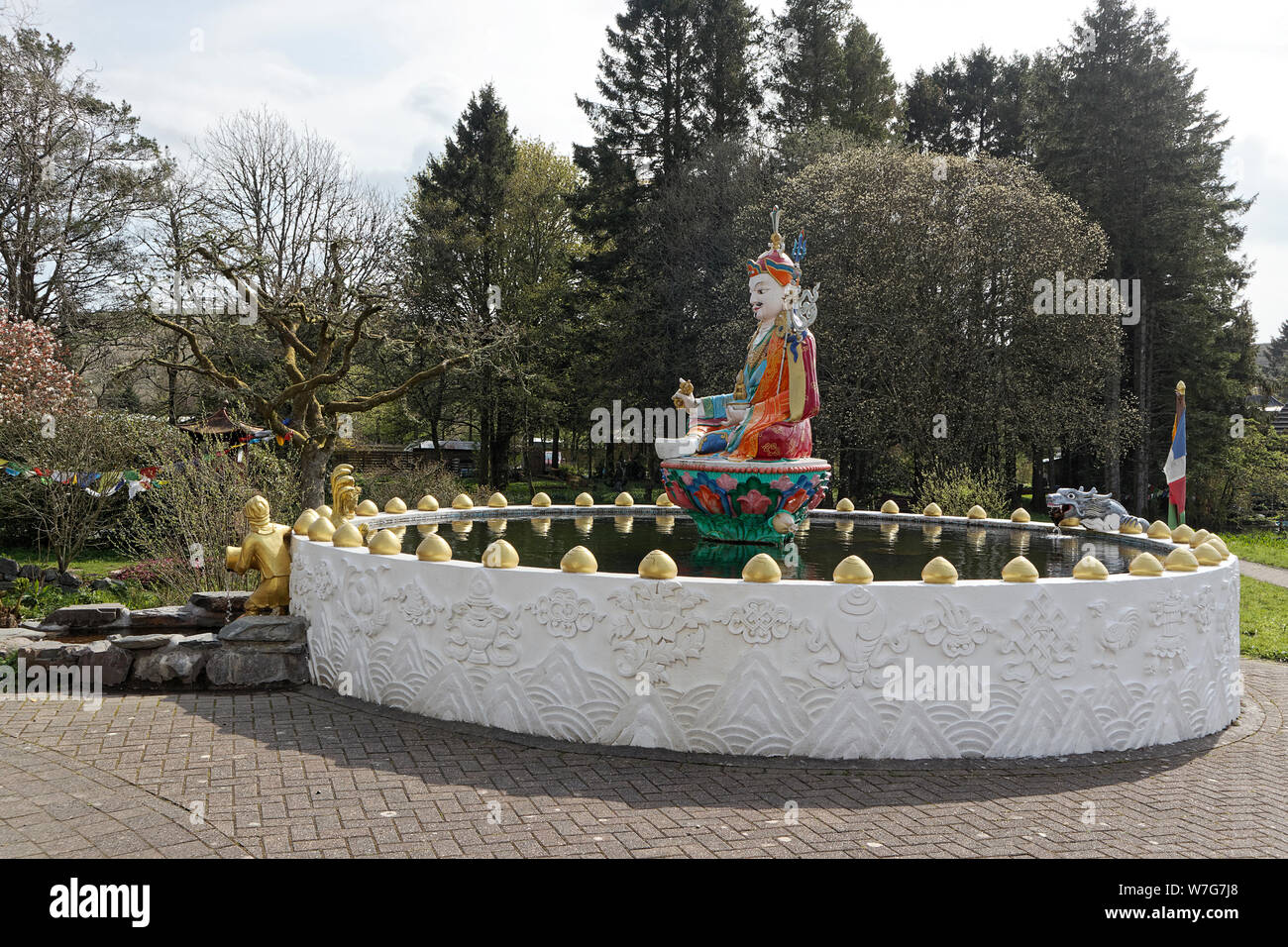 Kagyu Samye Ling Monastery and Tibetan Centre - Guru Rinpoche Stock Photohttps://www.alamy.com/image-license-details/?v=1https://www.alamy.com/kagyu-samye-ling-monastery-and-tibetan-centre-guru-rinpoche-image262815344.html
Kagyu Samye Ling Monastery and Tibetan Centre - Guru Rinpoche Stock Photohttps://www.alamy.com/image-license-details/?v=1https://www.alamy.com/kagyu-samye-ling-monastery-and-tibetan-centre-guru-rinpoche-image262815344.htmlRMW7G7J8–Kagyu Samye Ling Monastery and Tibetan Centre - Guru Rinpoche
 White Jambhala on a Dragon 18th–19th century Mongolia Although part of the jewel-born family associated with the Buddha Ratnasambhava, white Jambhala is said to have been born from the right eye of the compassionate bodhisattva Avalokiteshvara. He is identifiable by the dragon he rides and his gold sword, a variant of the khatvanga ritual staff, which he holds in his left hand. He alleviates suffering from poverty and sickness and purifies nonvirtuous karmic actions.. White Jambhala on a Dragon 39213 Stock Photohttps://www.alamy.com/image-license-details/?v=1https://www.alamy.com/white-jambhala-on-a-dragon-18th19th-century-mongolia-although-part-of-the-jewel-born-family-associated-with-the-buddha-ratnasambhava-white-jambhala-is-said-to-have-been-born-from-the-right-eye-of-the-compassionate-bodhisattva-avalokiteshvara-he-is-identifiable-by-the-dragon-he-rides-and-his-gold-sword-a-variant-of-the-khatvanga-ritual-staff-which-he-holds-in-his-left-hand-he-alleviates-suffering-from-poverty-and-sickness-and-purifies-nonvirtuous-karmic-actions-white-jambhala-on-a-dragon-39213-image458442087.html
White Jambhala on a Dragon 18th–19th century Mongolia Although part of the jewel-born family associated with the Buddha Ratnasambhava, white Jambhala is said to have been born from the right eye of the compassionate bodhisattva Avalokiteshvara. He is identifiable by the dragon he rides and his gold sword, a variant of the khatvanga ritual staff, which he holds in his left hand. He alleviates suffering from poverty and sickness and purifies nonvirtuous karmic actions.. White Jambhala on a Dragon 39213 Stock Photohttps://www.alamy.com/image-license-details/?v=1https://www.alamy.com/white-jambhala-on-a-dragon-18th19th-century-mongolia-although-part-of-the-jewel-born-family-associated-with-the-buddha-ratnasambhava-white-jambhala-is-said-to-have-been-born-from-the-right-eye-of-the-compassionate-bodhisattva-avalokiteshvara-he-is-identifiable-by-the-dragon-he-rides-and-his-gold-sword-a-variant-of-the-khatvanga-ritual-staff-which-he-holds-in-his-left-hand-he-alleviates-suffering-from-poverty-and-sickness-and-purifies-nonvirtuous-karmic-actions-white-jambhala-on-a-dragon-39213-image458442087.htmlRM2HHRRFK–White Jambhala on a Dragon 18th–19th century Mongolia Although part of the jewel-born family associated with the Buddha Ratnasambhava, white Jambhala is said to have been born from the right eye of the compassionate bodhisattva Avalokiteshvara. He is identifiable by the dragon he rides and his gold sword, a variant of the khatvanga ritual staff, which he holds in his left hand. He alleviates suffering from poverty and sickness and purifies nonvirtuous karmic actions.. White Jambhala on a Dragon 39213
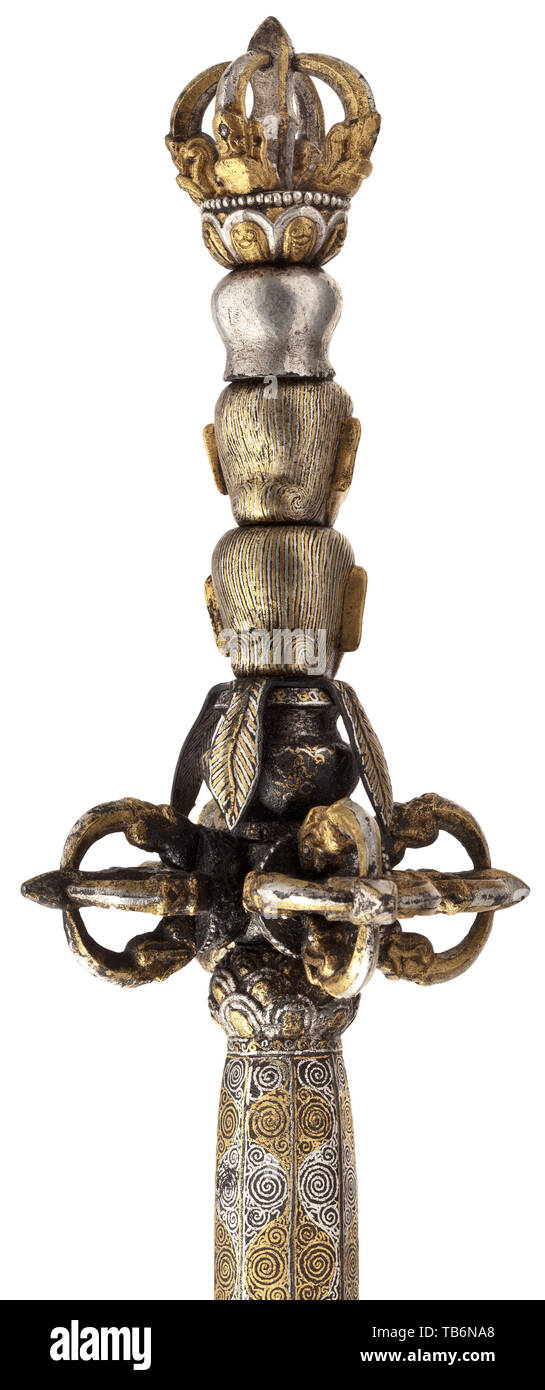 A Tibetan khatvanga with silver and gold inlays, early 15th century, Cut iron. Octagonal haft entirely covered with spiral-shaped gold and silver inlays, the lower part decorated with chiselled lotus flower in relief with a half vajra and gilt makara heads. The upper section with double vajra, followed by a kalasa, two different heads with gold and silver inlays and a skull, topped by a further vajra. Length 43.3 cm. The object at hand dates back to a significant period in the history of Tibet. During the late 14th and early 15th century the risi, Additional-Rights-Clearance-Info-Not-Available Stock Photohttps://www.alamy.com/image-license-details/?v=1https://www.alamy.com/a-tibetan-khatvanga-with-silver-and-gold-inlays-early-15th-century-cut-iron-octagonal-haft-entirely-covered-with-spiral-shaped-gold-and-silver-inlays-the-lower-part-decorated-with-chiselled-lotus-flower-in-relief-with-a-half-vajra-and-gilt-makara-heads-the-upper-section-with-double-vajra-followed-by-a-kalasa-two-different-heads-with-gold-and-silver-inlays-and-a-skull-topped-by-a-further-vajra-length-433-cm-the-object-at-hand-dates-back-to-a-significant-period-in-the-history-of-tibet-during-the-late-14th-and-early-15th-century-the-risi-additional-rights-clearance-info-not-available-image247854832.html
A Tibetan khatvanga with silver and gold inlays, early 15th century, Cut iron. Octagonal haft entirely covered with spiral-shaped gold and silver inlays, the lower part decorated with chiselled lotus flower in relief with a half vajra and gilt makara heads. The upper section with double vajra, followed by a kalasa, two different heads with gold and silver inlays and a skull, topped by a further vajra. Length 43.3 cm. The object at hand dates back to a significant period in the history of Tibet. During the late 14th and early 15th century the risi, Additional-Rights-Clearance-Info-Not-Available Stock Photohttps://www.alamy.com/image-license-details/?v=1https://www.alamy.com/a-tibetan-khatvanga-with-silver-and-gold-inlays-early-15th-century-cut-iron-octagonal-haft-entirely-covered-with-spiral-shaped-gold-and-silver-inlays-the-lower-part-decorated-with-chiselled-lotus-flower-in-relief-with-a-half-vajra-and-gilt-makara-heads-the-upper-section-with-double-vajra-followed-by-a-kalasa-two-different-heads-with-gold-and-silver-inlays-and-a-skull-topped-by-a-further-vajra-length-433-cm-the-object-at-hand-dates-back-to-a-significant-period-in-the-history-of-tibet-during-the-late-14th-and-early-15th-century-the-risi-additional-rights-clearance-info-not-available-image247854832.htmlRMTB6NA8–A Tibetan khatvanga with silver and gold inlays, early 15th century, Cut iron. Octagonal haft entirely covered with spiral-shaped gold and silver inlays, the lower part decorated with chiselled lotus flower in relief with a half vajra and gilt makara heads. The upper section with double vajra, followed by a kalasa, two different heads with gold and silver inlays and a skull, topped by a further vajra. Length 43.3 cm. The object at hand dates back to a significant period in the history of Tibet. During the late 14th and early 15th century the risi, Additional-Rights-Clearance-Info-Not-Available
 Ritual Staff (Khatvanga), Ming dynasty (1368–1644), Yongle period (1403–24), 1403–1424, China, Iron inlaid with gold and silver Stock Photohttps://www.alamy.com/image-license-details/?v=1https://www.alamy.com/stock-image-ritual-staff-khatvanga-ming-dynasty-13681644-yongle-period-140324-162432300.html
Ritual Staff (Khatvanga), Ming dynasty (1368–1644), Yongle period (1403–24), 1403–1424, China, Iron inlaid with gold and silver Stock Photohttps://www.alamy.com/image-license-details/?v=1https://www.alamy.com/stock-image-ritual-staff-khatvanga-ming-dynasty-13681644-yongle-period-140324-162432300.htmlRMKC7C1G–Ritual Staff (Khatvanga), Ming dynasty (1368–1644), Yongle period (1403–24), 1403–1424, China, Iron inlaid with gold and silver
 Art inspired by Finial for a Buddhist staff (khatvanga), Ming dynasty (1368–1644), early 15th century, China, Ivory, H. 3 1/2 in. (8.9 cm); W. 1 5/16 (3.3 cm); D. 1 1/16 in. (2.7 cm), Ivories, Used in Tibetan Buddhism, which was practiced at the Chinese court throughout the fifteenth, Classic works modernized by Artotop with a splash of modernity. Shapes, color and value, eye-catching visual impact on art. Emotions through freedom of artworks in a contemporary way. A timeless message pursuing a wildly creative new direction. Artists turning to the digital medium and creating the Artotop NFT Stock Photohttps://www.alamy.com/image-license-details/?v=1https://www.alamy.com/art-inspired-by-finial-for-a-buddhist-staff-khatvanga-ming-dynasty-13681644-early-15th-century-china-ivory-h-3-12-in-89-cm-w-1-516-33-cm-d-1-116-in-27-cm-ivories-used-in-tibetan-buddhism-which-was-practiced-at-the-chinese-court-throughout-the-fifteenth-classic-works-modernized-by-artotop-with-a-splash-of-modernity-shapes-color-and-value-eye-catching-visual-impact-on-art-emotions-through-freedom-of-artworks-in-a-contemporary-way-a-timeless-message-pursuing-a-wildly-creative-new-direction-artists-turning-to-the-digital-medium-and-creating-the-artotop-nft-image462908465.html
Art inspired by Finial for a Buddhist staff (khatvanga), Ming dynasty (1368–1644), early 15th century, China, Ivory, H. 3 1/2 in. (8.9 cm); W. 1 5/16 (3.3 cm); D. 1 1/16 in. (2.7 cm), Ivories, Used in Tibetan Buddhism, which was practiced at the Chinese court throughout the fifteenth, Classic works modernized by Artotop with a splash of modernity. Shapes, color and value, eye-catching visual impact on art. Emotions through freedom of artworks in a contemporary way. A timeless message pursuing a wildly creative new direction. Artists turning to the digital medium and creating the Artotop NFT Stock Photohttps://www.alamy.com/image-license-details/?v=1https://www.alamy.com/art-inspired-by-finial-for-a-buddhist-staff-khatvanga-ming-dynasty-13681644-early-15th-century-china-ivory-h-3-12-in-89-cm-w-1-516-33-cm-d-1-116-in-27-cm-ivories-used-in-tibetan-buddhism-which-was-practiced-at-the-chinese-court-throughout-the-fifteenth-classic-works-modernized-by-artotop-with-a-splash-of-modernity-shapes-color-and-value-eye-catching-visual-impact-on-art-emotions-through-freedom-of-artworks-in-a-contemporary-way-a-timeless-message-pursuing-a-wildly-creative-new-direction-artists-turning-to-the-digital-medium-and-creating-the-artotop-nft-image462908465.htmlRF2HW38D5–Art inspired by Finial for a Buddhist staff (khatvanga), Ming dynasty (1368–1644), early 15th century, China, Ivory, H. 3 1/2 in. (8.9 cm); W. 1 5/16 (3.3 cm); D. 1 1/16 in. (2.7 cm), Ivories, Used in Tibetan Buddhism, which was practiced at the Chinese court throughout the fifteenth, Classic works modernized by Artotop with a splash of modernity. Shapes, color and value, eye-catching visual impact on art. Emotions through freedom of artworks in a contemporary way. A timeless message pursuing a wildly creative new direction. Artists turning to the digital medium and creating the Artotop NFT
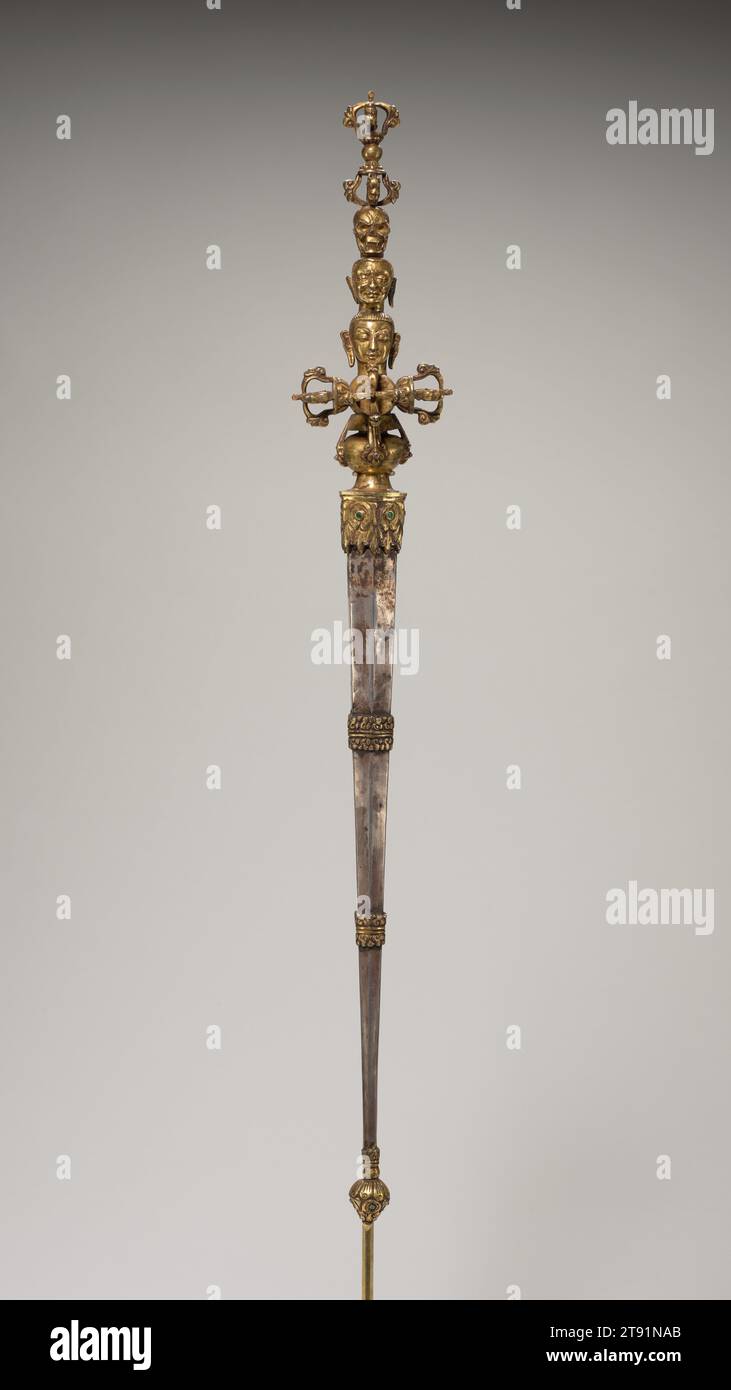 Khatvanga Ritual Staff, 18th century, 23 7/16 x 3 5/16 x 3 5/16 in. (59.53 x 8.41 x 8.41 cm), Silver, gold and turquoise, China, 18th century, A tantric staff, or khatvanga, is a ritual instrument held in the crook of the left arm of advanced Tantric (esoteric) Buddhist practitioners during ceremonies. It symbolizes the triumph of wisdom over illusion. The shaft terminates in a vajra, the thunderbolt of instant enlightenment. Above are three impaled heads in varying states of decay: a skull, or 'dry' head, signals the conquest of ignorance; the 'damp' head signals the victory over hate Stock Photohttps://www.alamy.com/image-license-details/?v=1https://www.alamy.com/khatvanga-ritual-staff-18th-century-23-716-x-3-516-x-3-516-in-5953-x-841-x-841-cm-silver-gold-and-turquoise-china-18th-century-a-tantric-staff-or-khatvanga-is-a-ritual-instrument-held-in-the-crook-of-the-left-arm-of-advanced-tantric-esoteric-buddhist-practitioners-during-ceremonies-it-symbolizes-the-triumph-of-wisdom-over-illusion-the-shaft-terminates-in-a-vajra-the-thunderbolt-of-instant-enlightenment-above-are-three-impaled-heads-in-varying-states-of-decay-a-skull-or-dry-head-signals-the-conquest-of-ignorance-the-damp-head-signals-the-victory-over-hate-image573512755.html
Khatvanga Ritual Staff, 18th century, 23 7/16 x 3 5/16 x 3 5/16 in. (59.53 x 8.41 x 8.41 cm), Silver, gold and turquoise, China, 18th century, A tantric staff, or khatvanga, is a ritual instrument held in the crook of the left arm of advanced Tantric (esoteric) Buddhist practitioners during ceremonies. It symbolizes the triumph of wisdom over illusion. The shaft terminates in a vajra, the thunderbolt of instant enlightenment. Above are three impaled heads in varying states of decay: a skull, or 'dry' head, signals the conquest of ignorance; the 'damp' head signals the victory over hate Stock Photohttps://www.alamy.com/image-license-details/?v=1https://www.alamy.com/khatvanga-ritual-staff-18th-century-23-716-x-3-516-x-3-516-in-5953-x-841-x-841-cm-silver-gold-and-turquoise-china-18th-century-a-tantric-staff-or-khatvanga-is-a-ritual-instrument-held-in-the-crook-of-the-left-arm-of-advanced-tantric-esoteric-buddhist-practitioners-during-ceremonies-it-symbolizes-the-triumph-of-wisdom-over-illusion-the-shaft-terminates-in-a-vajra-the-thunderbolt-of-instant-enlightenment-above-are-three-impaled-heads-in-varying-states-of-decay-a-skull-or-dry-head-signals-the-conquest-of-ignorance-the-damp-head-signals-the-victory-over-hate-image573512755.htmlRM2T91NAB–Khatvanga Ritual Staff, 18th century, 23 7/16 x 3 5/16 x 3 5/16 in. (59.53 x 8.41 x 8.41 cm), Silver, gold and turquoise, China, 18th century, A tantric staff, or khatvanga, is a ritual instrument held in the crook of the left arm of advanced Tantric (esoteric) Buddhist practitioners during ceremonies. It symbolizes the triumph of wisdom over illusion. The shaft terminates in a vajra, the thunderbolt of instant enlightenment. Above are three impaled heads in varying states of decay: a skull, or 'dry' head, signals the conquest of ignorance; the 'damp' head signals the victory over hate
 Finial for a Buddhist staff (khatvanga). Culture: China. Dimensions: H. 3 1/2 in. (8.9 cm); W. 1 5/16 (3.3 cm); D. 1 1/16 in. (2.7 cm). Date: early 15th century. Used in Tibetan Buddhism, which was practiced at the Chinese court throughout the fifteenth century, this finial would have capped a long staff used in rituals to quell demons that are symbolic of obstacles that must be overcome to reach enlightenment. Depicted on this implement are an overflowing vase--an Indic symbol of abundance--and three heads--one human, one decaying, and one skeletal--representing the inevitability of change a Stock Photohttps://www.alamy.com/image-license-details/?v=1https://www.alamy.com/finial-for-a-buddhist-staff-khatvanga-culture-china-dimensions-h-3-12-in-89-cm-w-1-516-33-cm-d-1-116-in-27-cm-date-early-15th-century-used-in-tibetan-buddhism-which-was-practiced-at-the-chinese-court-throughout-the-fifteenth-century-this-finial-would-have-capped-a-long-staff-used-in-rituals-to-quell-demons-that-are-symbolic-of-obstacles-that-must-be-overcome-to-reach-enlightenment-depicted-on-this-implement-are-an-overflowing-vase-an-indic-symbol-of-abundance-and-three-heads-one-human-one-decaying-and-one-skeletal-representing-the-inevitability-of-change-a-image213181510.html
Finial for a Buddhist staff (khatvanga). Culture: China. Dimensions: H. 3 1/2 in. (8.9 cm); W. 1 5/16 (3.3 cm); D. 1 1/16 in. (2.7 cm). Date: early 15th century. Used in Tibetan Buddhism, which was practiced at the Chinese court throughout the fifteenth century, this finial would have capped a long staff used in rituals to quell demons that are symbolic of obstacles that must be overcome to reach enlightenment. Depicted on this implement are an overflowing vase--an Indic symbol of abundance--and three heads--one human, one decaying, and one skeletal--representing the inevitability of change a Stock Photohttps://www.alamy.com/image-license-details/?v=1https://www.alamy.com/finial-for-a-buddhist-staff-khatvanga-culture-china-dimensions-h-3-12-in-89-cm-w-1-516-33-cm-d-1-116-in-27-cm-date-early-15th-century-used-in-tibetan-buddhism-which-was-practiced-at-the-chinese-court-throughout-the-fifteenth-century-this-finial-would-have-capped-a-long-staff-used-in-rituals-to-quell-demons-that-are-symbolic-of-obstacles-that-must-be-overcome-to-reach-enlightenment-depicted-on-this-implement-are-an-overflowing-vase-an-indic-symbol-of-abundance-and-three-heads-one-human-one-decaying-and-one-skeletal-representing-the-inevitability-of-change-a-image213181510.htmlRMPAR75A–Finial for a Buddhist staff (khatvanga). Culture: China. Dimensions: H. 3 1/2 in. (8.9 cm); W. 1 5/16 (3.3 cm); D. 1 1/16 in. (2.7 cm). Date: early 15th century. Used in Tibetan Buddhism, which was practiced at the Chinese court throughout the fifteenth century, this finial would have capped a long staff used in rituals to quell demons that are symbolic of obstacles that must be overcome to reach enlightenment. Depicted on this implement are an overflowing vase--an Indic symbol of abundance--and three heads--one human, one decaying, and one skeletal--representing the inevitability of change a
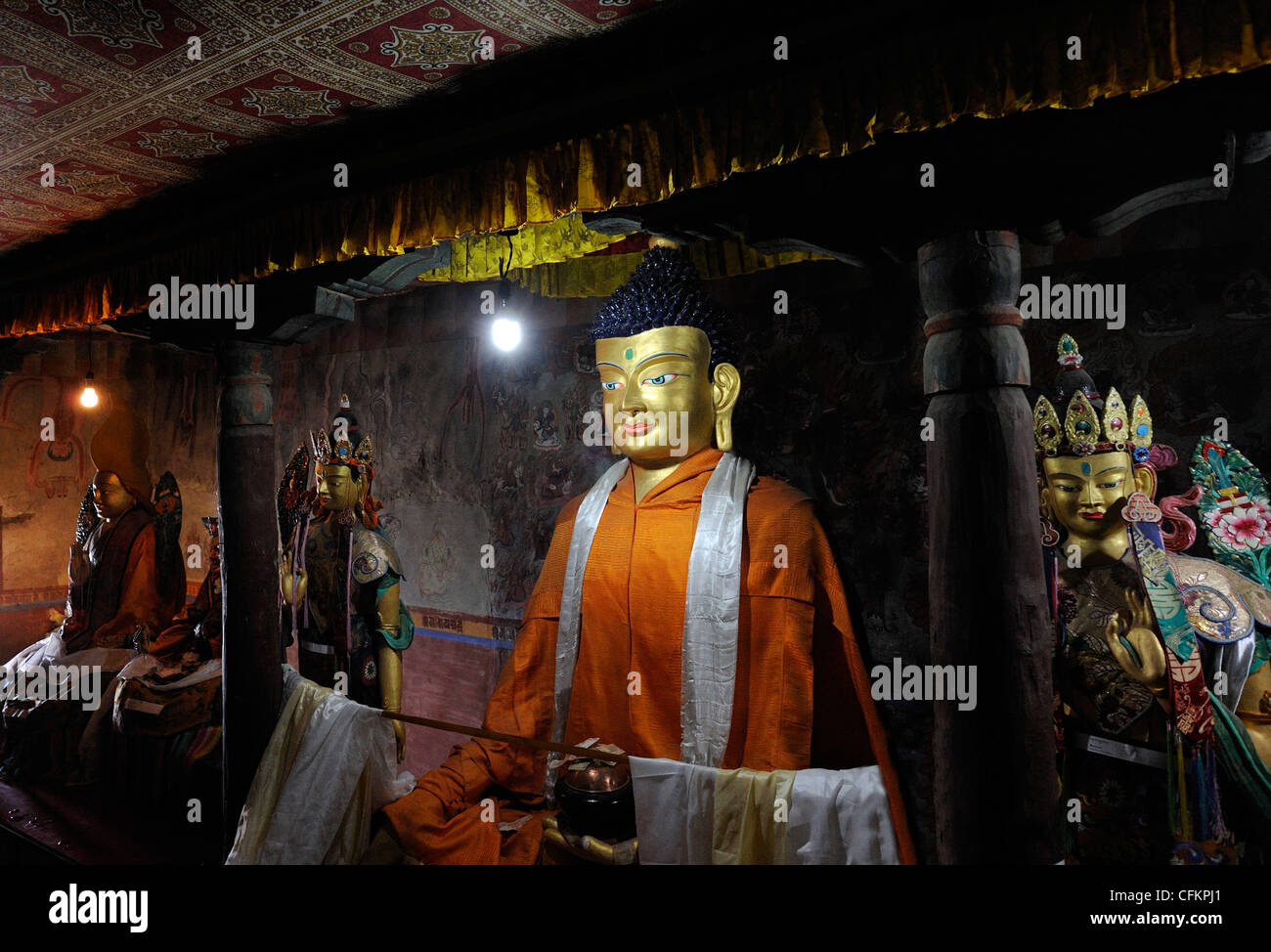 Statue of Shakyamuni Buddha, Gautama Buddha. In the background are statues of Guru Rinpoche and Maitreya future Buddha Stock Photohttps://www.alamy.com/image-license-details/?v=1https://www.alamy.com/stock-photo-statue-of-shakyamuni-buddha-gautama-buddha-in-the-background-are-statues-44075417.html
Statue of Shakyamuni Buddha, Gautama Buddha. In the background are statues of Guru Rinpoche and Maitreya future Buddha Stock Photohttps://www.alamy.com/image-license-details/?v=1https://www.alamy.com/stock-photo-statue-of-shakyamuni-buddha-gautama-buddha-in-the-background-are-statues-44075417.htmlRFCFKPJ1–Statue of Shakyamuni Buddha, Gautama Buddha. In the background are statues of Guru Rinpoche and Maitreya future Buddha
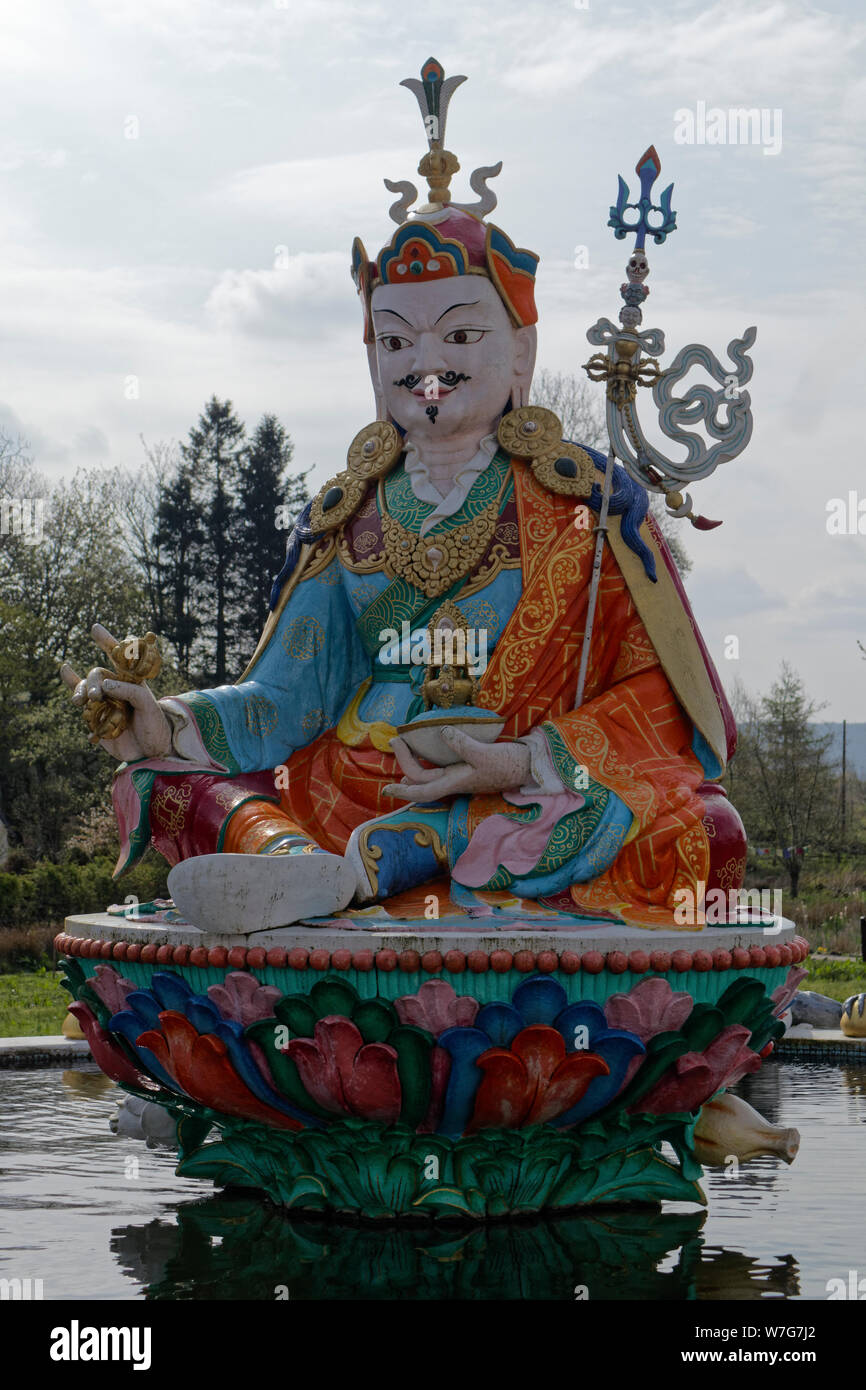 Kagyu Samye Ling Monastery and Tibetan Centre - Guru Rinpoche Stock Photohttps://www.alamy.com/image-license-details/?v=1https://www.alamy.com/kagyu-samye-ling-monastery-and-tibetan-centre-guru-rinpoche-image262815338.html
Kagyu Samye Ling Monastery and Tibetan Centre - Guru Rinpoche Stock Photohttps://www.alamy.com/image-license-details/?v=1https://www.alamy.com/kagyu-samye-ling-monastery-and-tibetan-centre-guru-rinpoche-image262815338.htmlRMW7G7J2–Kagyu Samye Ling Monastery and Tibetan Centre - Guru Rinpoche
 Finial for a Buddhist staff (khatvanga) early 15th century China Tibetan Buddhism was practiced at the Chinese court throughout the fifteenth century. This finial would have capped a long staff used in Buddhist rituals to quell demons, which are symbolic of obstacles that must be overcome to reach enlightenment. Depicted on this implement are an overflowing vase (an Indic symbol of abundance) and three heads (one human, one decaying, and one skeletal), which represent the inevitability of change and death. Listen to experts illuminate this artwork's story Listen Play or pause #7344. Finial for Stock Photohttps://www.alamy.com/image-license-details/?v=1https://www.alamy.com/finial-for-a-buddhist-staff-khatvanga-early-15th-century-china-tibetan-buddhism-was-practiced-at-the-chinese-court-throughout-the-fifteenth-century-this-finial-would-have-capped-a-long-staff-used-in-buddhist-rituals-to-quell-demons-which-are-symbolic-of-obstacles-that-must-be-overcome-to-reach-enlightenment-depicted-on-this-implement-are-an-overflowing-vase-an-indic-symbol-of-abundance-and-three-heads-one-human-one-decaying-and-one-skeletal-which-represent-the-inevitability-of-change-and-death-listen-to-experts-illuminate-this-artworks-story-listen-play-or-pause-7344-finial-for-image458489904.html
Finial for a Buddhist staff (khatvanga) early 15th century China Tibetan Buddhism was practiced at the Chinese court throughout the fifteenth century. This finial would have capped a long staff used in Buddhist rituals to quell demons, which are symbolic of obstacles that must be overcome to reach enlightenment. Depicted on this implement are an overflowing vase (an Indic symbol of abundance) and three heads (one human, one decaying, and one skeletal), which represent the inevitability of change and death. Listen to experts illuminate this artwork's story Listen Play or pause #7344. Finial for Stock Photohttps://www.alamy.com/image-license-details/?v=1https://www.alamy.com/finial-for-a-buddhist-staff-khatvanga-early-15th-century-china-tibetan-buddhism-was-practiced-at-the-chinese-court-throughout-the-fifteenth-century-this-finial-would-have-capped-a-long-staff-used-in-buddhist-rituals-to-quell-demons-which-are-symbolic-of-obstacles-that-must-be-overcome-to-reach-enlightenment-depicted-on-this-implement-are-an-overflowing-vase-an-indic-symbol-of-abundance-and-three-heads-one-human-one-decaying-and-one-skeletal-which-represent-the-inevitability-of-change-and-death-listen-to-experts-illuminate-this-artworks-story-listen-play-or-pause-7344-finial-for-image458489904.htmlRM2HHX0FC–Finial for a Buddhist staff (khatvanga) early 15th century China Tibetan Buddhism was practiced at the Chinese court throughout the fifteenth century. This finial would have capped a long staff used in Buddhist rituals to quell demons, which are symbolic of obstacles that must be overcome to reach enlightenment. Depicted on this implement are an overflowing vase (an Indic symbol of abundance) and three heads (one human, one decaying, and one skeletal), which represent the inevitability of change and death. Listen to experts illuminate this artwork's story Listen Play or pause #7344. Finial for
 A Tibetan khatvanga with silver and gold inlays, early 15th century, Cut iron. Octagonal haft entirely covered with spiral-shaped gold and silver inlays, the lower part decorated with chiselled lotus flower in relief with a half vajra and gilt makara heads. The upper section with double vajra, followed by a kalasa, two different heads with gold and silver inlays and a skull, topped by a further vajra. Length 43.3 cm. The object at hand dates back to a significant period in the history of Tibet. During the late 14th and early 15th century the risi, Additional-Rights-Clearance-Info-Not-Available Stock Photohttps://www.alamy.com/image-license-details/?v=1https://www.alamy.com/a-tibetan-khatvanga-with-silver-and-gold-inlays-early-15th-century-cut-iron-octagonal-haft-entirely-covered-with-spiral-shaped-gold-and-silver-inlays-the-lower-part-decorated-with-chiselled-lotus-flower-in-relief-with-a-half-vajra-and-gilt-makara-heads-the-upper-section-with-double-vajra-followed-by-a-kalasa-two-different-heads-with-gold-and-silver-inlays-and-a-skull-topped-by-a-further-vajra-length-433-cm-the-object-at-hand-dates-back-to-a-significant-period-in-the-history-of-tibet-during-the-late-14th-and-early-15th-century-the-risi-additional-rights-clearance-info-not-available-image247854830.html
A Tibetan khatvanga with silver and gold inlays, early 15th century, Cut iron. Octagonal haft entirely covered with spiral-shaped gold and silver inlays, the lower part decorated with chiselled lotus flower in relief with a half vajra and gilt makara heads. The upper section with double vajra, followed by a kalasa, two different heads with gold and silver inlays and a skull, topped by a further vajra. Length 43.3 cm. The object at hand dates back to a significant period in the history of Tibet. During the late 14th and early 15th century the risi, Additional-Rights-Clearance-Info-Not-Available Stock Photohttps://www.alamy.com/image-license-details/?v=1https://www.alamy.com/a-tibetan-khatvanga-with-silver-and-gold-inlays-early-15th-century-cut-iron-octagonal-haft-entirely-covered-with-spiral-shaped-gold-and-silver-inlays-the-lower-part-decorated-with-chiselled-lotus-flower-in-relief-with-a-half-vajra-and-gilt-makara-heads-the-upper-section-with-double-vajra-followed-by-a-kalasa-two-different-heads-with-gold-and-silver-inlays-and-a-skull-topped-by-a-further-vajra-length-433-cm-the-object-at-hand-dates-back-to-a-significant-period-in-the-history-of-tibet-during-the-late-14th-and-early-15th-century-the-risi-additional-rights-clearance-info-not-available-image247854830.htmlRMTB6NA6–A Tibetan khatvanga with silver and gold inlays, early 15th century, Cut iron. Octagonal haft entirely covered with spiral-shaped gold and silver inlays, the lower part decorated with chiselled lotus flower in relief with a half vajra and gilt makara heads. The upper section with double vajra, followed by a kalasa, two different heads with gold and silver inlays and a skull, topped by a further vajra. Length 43.3 cm. The object at hand dates back to a significant period in the history of Tibet. During the late 14th and early 15th century the risi, Additional-Rights-Clearance-Info-Not-Available
 White Jambhala on a Dragon. Culture: Mongolia. Dimensions: H. 5 1/4 in. (13.3 cm). Date: 18th-19th century. Although part of the jewel-born family associated with the Buddha Ratnasambhava, white Jambhala is said to have been born from the right eye of the compassionate bodhisattva Avalokiteshvara. He is identifiable by the dragon he rides and his gold sword, a variant of the khatvanga ritual staff, which he holds in his left hand. He alleviates suffering from poverty and sickness and purifies nonvirtuous karmic actions. Museum: Metropolitan Museum of Art, New York, USA. Stock Photohttps://www.alamy.com/image-license-details/?v=1https://www.alamy.com/white-jambhala-on-a-dragon-culture-mongolia-dimensions-h-5-14-in-133-cm-date-18th-19th-century-although-part-of-the-jewel-born-family-associated-with-the-buddha-ratnasambhava-white-jambhala-is-said-to-have-been-born-from-the-right-eye-of-the-compassionate-bodhisattva-avalokiteshvara-he-is-identifiable-by-the-dragon-he-rides-and-his-gold-sword-a-variant-of-the-khatvanga-ritual-staff-which-he-holds-in-his-left-hand-he-alleviates-suffering-from-poverty-and-sickness-and-purifies-nonvirtuous-karmic-actions-museum-metropolitan-museum-of-art-new-york-usa-image213501134.html
White Jambhala on a Dragon. Culture: Mongolia. Dimensions: H. 5 1/4 in. (13.3 cm). Date: 18th-19th century. Although part of the jewel-born family associated with the Buddha Ratnasambhava, white Jambhala is said to have been born from the right eye of the compassionate bodhisattva Avalokiteshvara. He is identifiable by the dragon he rides and his gold sword, a variant of the khatvanga ritual staff, which he holds in his left hand. He alleviates suffering from poverty and sickness and purifies nonvirtuous karmic actions. Museum: Metropolitan Museum of Art, New York, USA. Stock Photohttps://www.alamy.com/image-license-details/?v=1https://www.alamy.com/white-jambhala-on-a-dragon-culture-mongolia-dimensions-h-5-14-in-133-cm-date-18th-19th-century-although-part-of-the-jewel-born-family-associated-with-the-buddha-ratnasambhava-white-jambhala-is-said-to-have-been-born-from-the-right-eye-of-the-compassionate-bodhisattva-avalokiteshvara-he-is-identifiable-by-the-dragon-he-rides-and-his-gold-sword-a-variant-of-the-khatvanga-ritual-staff-which-he-holds-in-his-left-hand-he-alleviates-suffering-from-poverty-and-sickness-and-purifies-nonvirtuous-karmic-actions-museum-metropolitan-museum-of-art-new-york-usa-image213501134.htmlRMPB9PTE–White Jambhala on a Dragon. Culture: Mongolia. Dimensions: H. 5 1/4 in. (13.3 cm). Date: 18th-19th century. Although part of the jewel-born family associated with the Buddha Ratnasambhava, white Jambhala is said to have been born from the right eye of the compassionate bodhisattva Avalokiteshvara. He is identifiable by the dragon he rides and his gold sword, a variant of the khatvanga ritual staff, which he holds in his left hand. He alleviates suffering from poverty and sickness and purifies nonvirtuous karmic actions. Museum: Metropolitan Museum of Art, New York, USA.
 Statue of Guru Rinpoche, Precious Guru, Lopon Rinpoche, Padum, Padmasambhava, Padmakara, The Lotus Born, Stock Photohttps://www.alamy.com/image-license-details/?v=1https://www.alamy.com/stock-photo-statue-of-guru-rinpoche-precious-guru-lopon-rinpoche-padum-padmasambhava-43884546.html
Statue of Guru Rinpoche, Precious Guru, Lopon Rinpoche, Padum, Padmasambhava, Padmakara, The Lotus Born, Stock Photohttps://www.alamy.com/image-license-details/?v=1https://www.alamy.com/stock-photo-statue-of-guru-rinpoche-precious-guru-lopon-rinpoche-padum-padmasambhava-43884546.htmlRFCFB356–Statue of Guru Rinpoche, Precious Guru, Lopon Rinpoche, Padum, Padmasambhava, Padmakara, The Lotus Born,
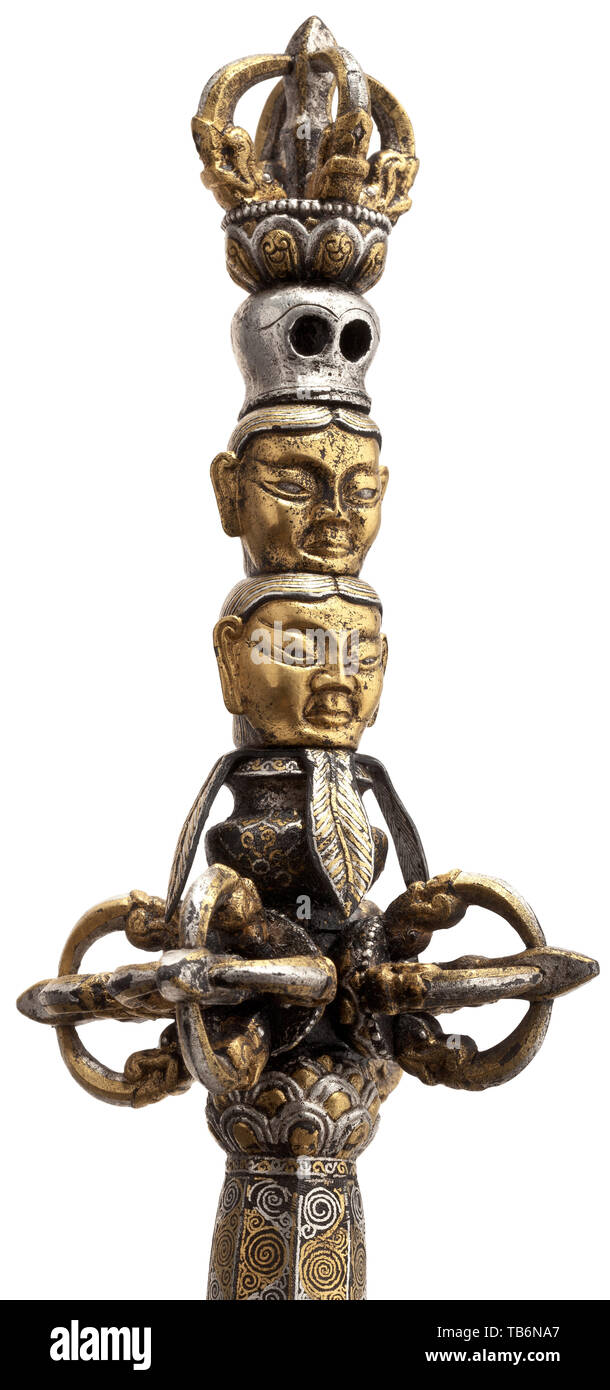 A Tibetan khatvanga with silver and gold inlays, early 15th century, Cut iron. Octagonal haft entirely covered with spiral-shaped gold and silver inlays, the lower part decorated with chiselled lotus flower in relief with a half vajra and gilt makara heads. The upper section with double vajra, followed by a kalasa, two different heads with gold and silver inlays and a skull, topped by a further vajra. Length 43.3 cm. The object at hand dates back to a significant period in the history of Tibet. During the late 14th and early 15th century the risi, Additional-Rights-Clearance-Info-Not-Available Stock Photohttps://www.alamy.com/image-license-details/?v=1https://www.alamy.com/a-tibetan-khatvanga-with-silver-and-gold-inlays-early-15th-century-cut-iron-octagonal-haft-entirely-covered-with-spiral-shaped-gold-and-silver-inlays-the-lower-part-decorated-with-chiselled-lotus-flower-in-relief-with-a-half-vajra-and-gilt-makara-heads-the-upper-section-with-double-vajra-followed-by-a-kalasa-two-different-heads-with-gold-and-silver-inlays-and-a-skull-topped-by-a-further-vajra-length-433-cm-the-object-at-hand-dates-back-to-a-significant-period-in-the-history-of-tibet-during-the-late-14th-and-early-15th-century-the-risi-additional-rights-clearance-info-not-available-image247854831.html
A Tibetan khatvanga with silver and gold inlays, early 15th century, Cut iron. Octagonal haft entirely covered with spiral-shaped gold and silver inlays, the lower part decorated with chiselled lotus flower in relief with a half vajra and gilt makara heads. The upper section with double vajra, followed by a kalasa, two different heads with gold and silver inlays and a skull, topped by a further vajra. Length 43.3 cm. The object at hand dates back to a significant period in the history of Tibet. During the late 14th and early 15th century the risi, Additional-Rights-Clearance-Info-Not-Available Stock Photohttps://www.alamy.com/image-license-details/?v=1https://www.alamy.com/a-tibetan-khatvanga-with-silver-and-gold-inlays-early-15th-century-cut-iron-octagonal-haft-entirely-covered-with-spiral-shaped-gold-and-silver-inlays-the-lower-part-decorated-with-chiselled-lotus-flower-in-relief-with-a-half-vajra-and-gilt-makara-heads-the-upper-section-with-double-vajra-followed-by-a-kalasa-two-different-heads-with-gold-and-silver-inlays-and-a-skull-topped-by-a-further-vajra-length-433-cm-the-object-at-hand-dates-back-to-a-significant-period-in-the-history-of-tibet-during-the-late-14th-and-early-15th-century-the-risi-additional-rights-clearance-info-not-available-image247854831.htmlRMTB6NA7–A Tibetan khatvanga with silver and gold inlays, early 15th century, Cut iron. Octagonal haft entirely covered with spiral-shaped gold and silver inlays, the lower part decorated with chiselled lotus flower in relief with a half vajra and gilt makara heads. The upper section with double vajra, followed by a kalasa, two different heads with gold and silver inlays and a skull, topped by a further vajra. Length 43.3 cm. The object at hand dates back to a significant period in the history of Tibet. During the late 14th and early 15th century the risi, Additional-Rights-Clearance-Info-Not-Available